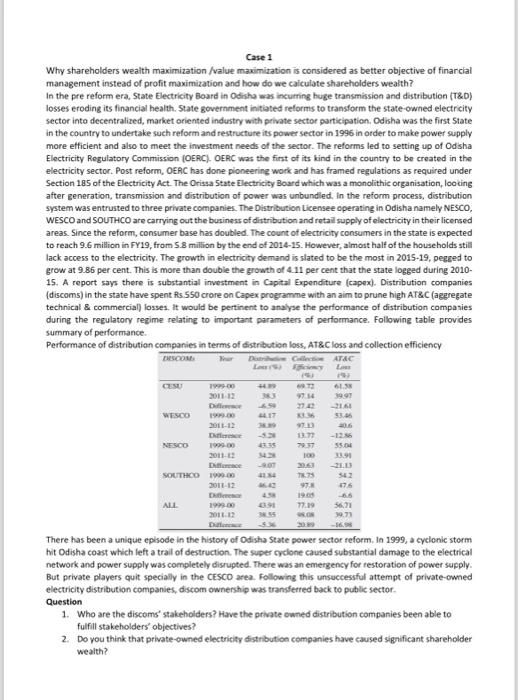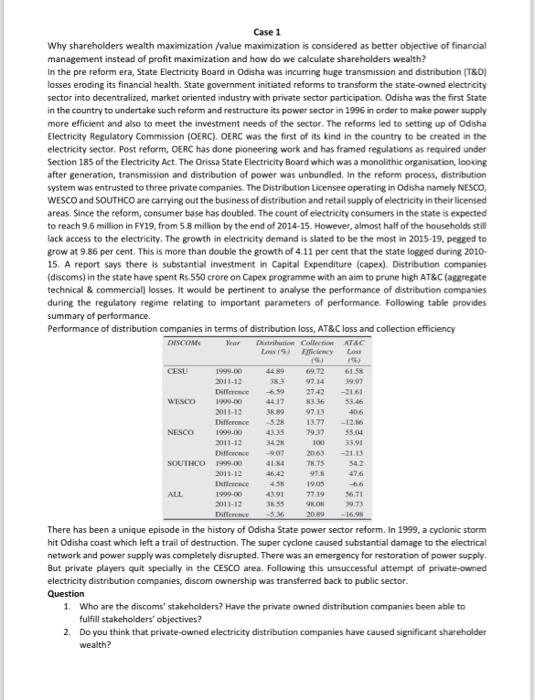Case 1 Why shareholders wealth maximization /value maximization is considered as better objective of financial management instead of profit maximization and how do we calculate shareholders wealth? In the pre reform era, State Electricity Board in Odisha was incurring huge transmission and distribution (T&D) losses eroding its financial health. State government initiated reforms to transform the state-owned electricity sector into decentralized, market oriented industry with private sector participation. Odisha was the first State in the country to undertake such reform and restructure its power sector in 1996 in order to make power supply more efficient and also to meet the investment needs of the sector. The reforms led to setting up of Odisha Electricity Regulatory Commission (OERC). OERC was the first of its kind in the country to be created in the electricity sector. Post reform, OERC has done pioneering work and has framed regulations as required under Section 185 of the Electricity Act. The Orissa State Electricity Board which was a monolithic organisation, looking after generation, transmission and distribution of power was unbundled. In the reform process, distribution system was entrusted to three private companies. The Distribution Licensee operating in Odisha namely NESCO, WESCO and SOUTHCO are carrying out the business of distribution and retail supply of electricity in their licensed areas. Since the reform, consumer base has doubled. The count of electricity consumers in the state is expected to reach 9.6 million in FY19, from 5.8 million by the end of 2014-15. However, almost half of the households still lack access to the electricity. The growth in electricity demand is slated to be the most in 2015-19, pegged to grow at 9.86 per cent. This is more than double the growth of 4.11 per cent that the state logged during 2010- 15. A report says there is substantial investment in Capital Expenditure (capex). Distribution companies (discoms) in the state have spent Rs.550 crore on Capex programme with an aim to prune high AT&C (aggregate technical & commercial) losses. It would be pertinent to analyse the performance of distribution companies during the regulatory regime relating to important parameters of performance. Following table provides summary of performance. Performance of distribution companies in terms of distribution loss, AT&C loss and collection efficiency DISCOMS Year CESU WESCO NESCO SOUTHCO ALL 1999-00 2011-12 Difference 1999-00 2011-12 Difference 1999-00 2011-12 Difference 1999-00 2011-12 Difference 1999-00 2011-12 Difference Distribution Collection Loss (%) Efficiency (%) 69.72 97.14 27.42 83.36 97.13 13.77 79.37 100 20.63 -21.13 78.75 54.2 97.8 47.6 19.05 -6.6 77.19 56.71 98.08 39.73 20.89 -16.98 44.89 38.3 -6.59 44.17 38.89 -5.28 43.35 34.28 -9.07 41.84 46.42 4.58 43.91 38.55 -5.36 AT&C Loss (%) 61.58 39.97 -21.61 53.46 40.6 -12.86 55.04 33.91 There has been a unique episode in the history of Odisha State power sector reform. In 1999, a cyclonic storm hit Odisha coast which left a trail of destruction. The super cyclone caused substantial damage to the electrical network and power supply was completely disrupted. There was an emergency for restoration of power supply. But private players quit specially in the CESCO area. Following this unsuccessful attempt of private-owned electricity distribution companies, discom ownership was transferred back to public sector. Question 1. Who are the discoms' stakeholders? Have the private owned distribution companies been able to fulfill stakeholders' objectives? 2. Do you think that private-owned electricity distribution companies have caused significant shareholder wealth?


Case 1 Why shareholders wealth maximization /value maximitation is considered as better objective of finarcial management instead of profit maximization and how do we calculate shareholders wealth? In the pre reform era, State Electricity Board in Odisha was incurring huge transmission and distribution (T\&D) losses eroding its financial health. State government initiated reforms to transform the state-owned electricity sector into decentralized, market oriented industry with private sector participation. Odisha was the first State in the country to undertake such reform and restructure its power sector in 1996 in order to make power supply more efficient and also to meet the investment needs of the sector. The reforms led to setting up of Odisha Electricity Regulatory Commission (OERC). OERC was the first of its kind in the country to be created in the electricity sector. Post reform, OERC has done pioneering work and has framed regulations as required under Section 185 of the Electricity Act. The Orisas State Electricity Board which was a monolithic organisation, looking after generation, transmission and distribution of power was unbundled. in the reform process, distribution system was entrusted to three private companies. The Distriburtion Licensee operating in Odisha namely NESCO, WESCO and SOUTHCO are carrying out the business of distribution and retail supply of electricity in their licensed areas. Since the reform, consumer base has doubled. The count of electricity consumers in the state is expected to reach 9.6 million in FY19, from 5.8 million by the end of 2014-15. However, almost half of the households still lack access to the electricity. The growth in electricity demand is slated to be the most in 2015-19, pegeed to grow at 9.86 per cent. This is more than double the growth of 4.11 per cent that the state logged during 201015. A report says there is substantial investment in Capital Expenditure (capex). Distribution companies (discoms) in the state have spent fls 550 crore on Capex programme with an aim to prune high AT\&C (aggregate technical \& commercial) losses. It would be pertinent to analyse the performance of distribution compasies during the regulatory regime relating to important parameters of performance. Following table provides summary of performance. Performance of distribution companies in terms of distribution loss, AT\&C loss and collection efficiency There has been a unique episode in the history of Odisha State power sector reform. 10 1999, a cyclonic storm hit Odisha coast which left a trail of destruction. The super cyclone caused substantial damage to the electrical network and power supply was completely disrupted. There was an emergency for restoration of power supply. But private players quit specially in the CESCO area. Following this unsuccessful attempt of private-owned electricity distribution companies, discom ownership was transferted back to public sector. Question 1. Who are the discoms' stakeholders? Have the private owned distribution companies been able to fulfill stakeholder' objectives? 2. Do you think that private-owned electricity distribution companies have caused sigrificant shareholder wealth? Case 1 Why shareholders wealth maximization /value maximization is considered as better objective of finarcial management instead of profit maximization and how do we calculate shareholders wealth? In the pre reform era, State Electricity Board in Odisha was incurring huge transmission and distribution (T\&D) losses eroding its financial health. State government initiated reforms to transform the state-owned electricity sector into decentralized, market oriented industry with private sector participation. Odisha was the first State in the country to undertake such reform and restructure its power sector in 1996 in order to make power supply more efficient and also to meet the investment needs of the sector. The reforms led to setting up of Odisha Electricity Regulatory Commission (OERC). OERC was the first of its kind in the country to be created in the electricity sector. Post reform, OERC has done pioneering work and has framed regulations as required under Section 185 of the Electricity Act. The Orissa State Electricity Board which was a monolithic organisation, loocing after generation, transmission and distribution of power was unbundled. In the reform process, distribution system was entrusted to three private companies. The Distribution Licensee operating in Odisha namely NESCO, WESCO and SOUTHCO are carrying out the business of distribution and retail supply of electricity in their licensed areas. Since the reform, consumer base has doubled. The count of electricity consumers in the state is expected to reach 9.6 million in FY19, from 5.8 million by the end of 2014-15. However, almost half of the households still lack access to the electricity. The growth in electricity demand is slated to be the most in 2015-19, pegeed to grow at 9.86 per cent. This is more than double the growth of 4.11 per cent that the state logged during 2010 . 15. A report says there is substantial investment in Capital Expenditure (capex). Distribution companies (discoms) in the state have spent Rs.550 crore on Capex programme with an aim to prune high AT\&C (aggregate technical & commercial) losses. It would be pertinent to analyse the performance of distribution companies during the regulatory regime relating to important parameters of performance. Following table provides summary of performance. Performance of distribution companies in terms of distribution loss, AT\&C loss and collection efficiency There has been a unique episode in the history of Odisha State power sector reform. In 1999, a cyclonic storm hit Odisha coast which left a trail of destruction. The super cyclone caused substantial damage to the electrical network and power supply was completely disrupted. There was an emergency for restoration of power supply. But private players quit specially in the CESCO area. Following this unsuccessful attempt of private-owned electricity distribution companies, discom ownership was transferred back to public sector. Question 1. Who are the discoms' stakeholders? Have the private owned distribution companies been able to fulfill stakeholders' objectives? 2. Do you think that private-owned electricity distribution companies have caused significant shareholder wealth








